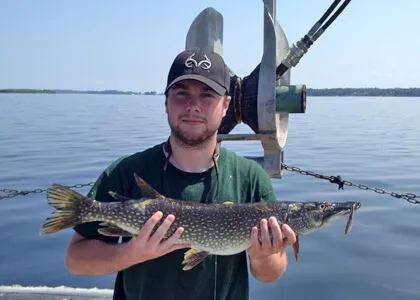With the summer of 2013 fast approaching I still had no summer work plans. I knew I wanted to work within my field of interest, fisheries, but had no idea how I was going to make it happen. But with one email to a Vermont Fish and Wildlife Fisheries Biologist I met during one of my classes, I got the opportunity I was looking for. That opportunity was to work with Vermont Fish and Wildlife conducting a study on the potential effects of invasive fish species on native fish species.
To do this, the focus would be on one native species, yellow perch, and two recent invasive species, alewife and white perch. By using age estimation processes as well as length and weight data, growth of the previously mentioned target species would be used to determine any changes over the study period (2005-2012).
The summer started in the lab where pre-removed otoliths—a hard calcium carbonate structure located behind the brain of fish commonly known as ear stones—were split and heated over an open flame. This was done to bring out the “rings” within the otolith, which were visible under a microscope. The rings were then counted, like counting the rings of a tree trunk, to determine the age of the individual fish. This process provided the ability to match the age of an individual fish with its predetermined length and weight, information that would be necessary for growth analysis.
After about a month of lab work almost all of the samples had been examined and the fieldwork portion of the study began. Even though there would not be enough time to work up (determine length, weight, and remove otoliths) all of the fish caught in 2013 for use in the study I was conducting, it was a vital step in understanding the processes that went into collecting the fish I would be analyzing.
Every day for a month we embarked on the Doré (Vermont Fish and Wildlife’s research vessel) to locations all over Lake Champlain. Using bottom trawls and gill nets, fish communities were sampled in the same places they have been sampled for decades in order to determine any population shifts that may be occurring. All the fish caught in each net and bottom trawl were separated by species, then counted. A subsample from each species was then bagged and labeled for future analysis in the lab. Being a part of the process had a substantial effect on my ability to evaluate the data sheets I had been using in the lab and really increased the speed at which I could process samples.
When the fieldwork portion ended, it was back to the lab to start the data analysis portion of the study. Using the information found during my first stint in the lab, I began to combine data and summarize what I had found. Data was organized by fish species, gender, year sampled, and sampling location (location they were caught). Average length at age, catch per unit effort, length/weight regressions, and condition factor were then determined for each of the previously mentioned groups. Statistical tests were then run to determine if there was any variation between years, sex, and sampling location.
This is where my summer journey ended. However, I am still in the process of writing a manuscript for journal entry and putting together a presentation of my findings. My one piece of advice to future internship hopefuls would be to not be afraid to put yourself out there. There are more opportunities than just the ones you receive via email through UVM. It may take some extra work, but in the end you won’t regret it.
